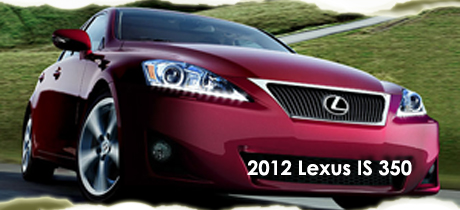
2012 Lexus IS 350 Road Test Review
By Bob Plunkett
So we're pointing toward the White River port town of Calico Rock on a curvy back road course in the Ozark Mountains of Arkansas while steering a rear-wheel-drive sports sedan from Lexus, elite up-shoot brand from Toyota of Japan.
Our test car -- the 2012 Lexus IS 350 with F Sport trim -- looks like a high-strung rally car, oversized wheels pegged at the corners and a contoured body characterized by the low arching profile, flat side panels and a blunt prow and tail with scant overhangs.
It behaves like a road-hugging German touring sedan, a taut suspension tuned to allow tires to dance around curvy mountain corners on the narrow and snaky Arkansas 5 as a powerful V6 engine pushes tall torque to the rear rollers.
Unlike some Teutonic machines, however, the IS 350 also carries lavish appointments in a leather-lined cockpit with glossy hardwood or metallic accents.
Then there's the high-tech angle with a stunning array of computerized controls.
A key element is the VDIM -- Vehicle Dynamics Integrated Management -- system.
Tapping into a host of sensors -- tracking such vehicle functions as the angle of the steering wheel, the turn rate of each wheel, lateral motion of the car body, and pressure on brake and accelerator pedals -- the VDIM constantly analyzes all collected data and uses it to deploy various traction controllers and maintain stability.
Acronyms in car safety include the anti-lock brake system (ABS), traction control (TRAC), vehicle stability control (VSC), brake assist (BA), plus electronic throttle control (ETC) and even a pre-collision system (PCS) to reduce collision damage.
The VDIM coordinates the ABS and BA with VSC, TRAC and ETC systems -- it can actually anticipate a vehicle control problem and then go to work automatically to remedy the problem through brake and throttle restraints.
In effect, VDIM enables the IS driver to perform at a level that's perhaps a step above innate skills -- you come off as an expert in car control even if you don't realize you are one.
The IS series of compact-class sports sedans from Lexus traces to debut editions of 2001. Then in 2006 the series expanded for second-generation designs with three models powered by new V6 engines and six-speed automatic and manual transmissions, plus optional all-wheel-drive (AWD) traction.
Revised body styling applied to 2011 issues and for 2012 the F Sport package works on RWD versions of the IS 250 and IS 350.
The F Sport package -- inspired by the Lexus IS F ultra-performance sedan -- brings special suspension and steering tuning with alloy wheels finished in dark chrome.
Also, the package attaches a front lip spoiler, rear deck spoiler and dark-chrome front grille insert.
In the cockpit, the F Sport gains a sport steering wheel and shift knob, heated front seats with microfiber insert and leather side bolsters, and F Sport badging on steering wheel, shift knob and doorsill scuff plates.
The stiff platform underpinning the IS series has a wheelbase length of 107.5 inches with the width of the wheel track stretched to 60.4 inches.
To this long and broad platform goes the front and rear suspension system. There are double wishbones up front with high-mount upper arms, coil springs, gas-filled shocks and stabilizer bar. The sophisticated rear multi-link arrangement also employs high-mount upper arms with coil springs, gas-filled shocks and a stabilizer bar.
The electric power steering (EPS) system uses a quick-ratio rack and pinion setup with speed-sensing variable assistance.
Brakes consist of vented front rotors (11.65-inch) and sold rear rotors (11.45-inch).
Two V6 engines define the IS models.
Standard plant is a direct-injection 2.5-liter V6 with dual overhead cams (DOHC) and Toyota's intelligent variable valve timing (VVT-i) plus dual exhaust.
It generates 204 hp at 6400 rpm and 185 lb-ft of torque at 4800 rpm.
The 2.5-liter V6 drops into the IS 250, with RWD and AWD traction options.
IS 250 with RWD mode shows two six-speed transmission choices -- manual or automatic.
The manual shifts smoothly and has a respectably short shift lever.
The automatic puts shifter paddles on the steering wheel, which allow an aggressive driver to shift up and down sans clutch with only a flick of the finger and without removing hands from the wheel.
A robust direct-injection 3.5-liter V6, also with VVT-i, links exclusively with the six-speed paddle-shifted automatic to define top models IS 350 RWD and IS 350 AWD.
This plant hits 306 hp at 6400 rpm with torque of 277 lb-ft at 4800 rpm.
MSRP numbers for the 2012 IS series start with the IS 250 manual transmission pegged at $33,595, or $34,765 for the paddle-shift automatic, and $37,225 for AWD traction.
IS 350 RWD begins at $40,020, or $42,480 with AWD.
For more info on the Lexus IS, click here.
Visit RTM's Road Test Review Archive |